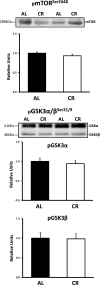Improved insulin sensitivity with calorie restriction does not require reduced JNK1/2, p38, or ERK1/2 phosphorylation in skeletal muscle of 9-month-old rats
- PMID: 22012698
- PMCID: PMC3349379
- DOI: 10.1152/ajpregu.00372.2011
Improved insulin sensitivity with calorie restriction does not require reduced JNK1/2, p38, or ERK1/2 phosphorylation in skeletal muscle of 9-month-old rats
Abstract
Calorie restriction [CR; ∼40% below ad libitum (AL) intake] improves the health of many species, including rats, by mechanisms that may be partly related to enhanced insulin sensitivity for glucose disposal by skeletal muscle. Excessive activation of several mitogen-activated protein kinases (MAPKs), including JNK1/2, p38, and ERK1/2 has been linked to insulin resistance. Although insulin can activate ERK1/2, this effect is not required for insulin-mediated glucose uptake. We hypothesized that skeletal muscle from male 9-mo-old Fischer 344/Brown Norway rats CR (35-40% beginning at 3 mo old) versus AL rats would have 1) attenuated activation of JNK1/2, p38, and ERK1/2 under basal conditions; and 2) no difference for insulin-induced ERK1/2 activation. In contrast to our hypothesis, there were significant CR-related increases in the phosphorylation of p38 (epitrochlearis, soleus, and gastrocnemius), JNK1 (epitrochlearis and soleus), and JNK2 (gastrocnemius). Consistent with our hypothesis, CR did not alter insulin-mediated ERK1/2 activation. The greater JNK1/2 and p38 phosphorylation with CR was not attributable to diet effects on muscle oxidative stress (assessed by protein carbonyls and 4-hydroxynonenal protein conjugates). In muscles from the same rats used for the present study, we previously reported a CR-related increase in insulin-mediated glucose uptake by the epitrochlearis and the soleus (Sharma N, Arias EB, Bhat AD, Sequea DA, Ho S, Croff KK, Sajan MP, Farese RV, Cartee GD. Am J Physiol Endocrinol Metab 300: E966-E978, 2011). The present results indicate that the improved insulin sensitivity with CR is not attributable to attenuated MAPK phosphorylation in skeletal muscle.
Figures







Similar articles
-
Heterogeneous effects of calorie restriction on in vivo glucose uptake and insulin signaling of individual rat skeletal muscles.PLoS One. 2013 Jun 3;8(6):e65118. doi: 10.1371/journal.pone.0065118. Print 2014. PLoS One. 2013. PMID: 23755179 Free PMC article.
-
Greater insulin-mediated Akt phosphorylation concomitant with heterogeneous effects on phosphorylation of Akt substrates in soleus of calorie-restricted rats.Am J Physiol Regul Integr Comp Physiol. 2012 Dec 15;303(12):R1261-7. doi: 10.1152/ajpregu.00457.2012. Epub 2012 Oct 31. Am J Physiol Regul Integr Comp Physiol. 2012. PMID: 23115120 Free PMC article.
-
Age-related differences in skeletal muscle insulin signaling: the role of stress kinases and heat shock proteins.J Appl Physiol (1985). 2008 Sep;105(3):839-48. doi: 10.1152/japplphysiol.00148.2008. Epub 2008 Jul 3. J Appl Physiol (1985). 2008. PMID: 18599680
-
p38 MAPK in Glucose Metabolism of Skeletal Muscle: Beneficial or Harmful?Int J Mol Sci. 2020 Sep 4;21(18):6480. doi: 10.3390/ijms21186480. Int J Mol Sci. 2020. PMID: 32899870 Free PMC article. Review.
-
Oxidative stress and the etiology of insulin resistance and type 2 diabetes.Free Radic Biol Med. 2011 Sep 1;51(5):993-9. doi: 10.1016/j.freeradbiomed.2010.12.005. Epub 2010 Dec 13. Free Radic Biol Med. 2011. PMID: 21163347 Free PMC article. Review.
Cited by
-
Akt substrate of 160 kDa is essential for the calorie restriction-induced increase in insulin-stimulated glucose uptake by skeletal muscle of female rats.Appl Physiol Nutr Metab. 2023 Mar 1;48(3):283-292. doi: 10.1139/apnm-2022-0414. Epub 2023 Jan 12. Appl Physiol Nutr Metab. 2023. PMID: 36634338 Free PMC article.
-
The role of glycogen synthase kinase 3 beta in brain injury induced by myocardial ischemia/reperfusion injury in a rat model of diabetes mellitus.Neural Regen Res. 2017 Oct;12(10):1632-1639. doi: 10.4103/1673-5374.217337. Neural Regen Res. 2017. PMID: 29171428 Free PMC article.
-
Early dietary restriction in rats alters skeletal muscle tuberous sclerosis complex, ribosomal s6 and mitogen-activated protein kinase.Nutr Res. 2018 Jun;54:93-104. doi: 10.1016/j.nutres.2018.03.013. Epub 2018 Mar 23. Nutr Res. 2018. PMID: 29685622 Free PMC article.
-
Calorie restriction leads to greater Akt2 activity and glucose uptake by insulin-stimulated skeletal muscle from old rats.Am J Physiol Regul Integr Comp Physiol. 2016 Mar 1;310(5):R449-58. doi: 10.1152/ajpregu.00449.2015. Epub 2016 Jan 6. Am J Physiol Regul Integr Comp Physiol. 2016. PMID: 26739650 Free PMC article.
-
Early Life Stress Induced by Limited Nesting Material Produces Metabolic Resilience in Response to a High-Fat and High-Sugar Diet in Male Rats.Front Endocrinol (Lausanne). 2015 Sep 7;6:138. doi: 10.3389/fendo.2015.00138. eCollection 2015. Front Endocrinol (Lausanne). 2015. PMID: 26441828 Free PMC article.
References
-
- Al-Regaiey KA, Masternak MM, Bonkowski MS, Panici JA, Kopchick JJ, Bartke A. Effects of caloric restriction and growth hormone resistance on insulin-related intermediates in the skeletal muscle. J Gerontol A Biol Sci Med Sci 62: 18–26, 2007 - PubMed
-
- Arkan MC, Hevener AL, Greten FR, Maeda S, Li ZW, Long JM, Wynshaw-Boris A, Poli G, Olefsky J, Karin M. IKK-β links inflammation to obesity-induced insulin resistance. Nat Med 11: 191–198, 2005 - PubMed
-
- Bak JF, Moller N, Schmitz O, Saaek A, Pedersen O. In vivo insulin action and muscle glycogen synthase activity in type 2 (non-insulin-dependent) diabetes mellitus: effects of diet treatment. Diabetologia 35: 777–784, 1992 - PubMed
-
- Balage M, Grizard J, Manin M. Effect of calorie restriction on skeletal muscle and liver insulin binding in growing rat. Horm Metab Res 22: 207–214, 1990 - PubMed
-
- Barbieri M, Boccardi V, Papa M, Paolisso G. Metabolic journey to healthy longevity. Horm Res 71, Suppl 1: 24–27, 2009 - PubMed
Publication types
MeSH terms
Substances
Grants and funding
LinkOut - more resources
Full Text Sources
Research Materials
Miscellaneous

